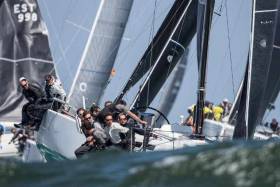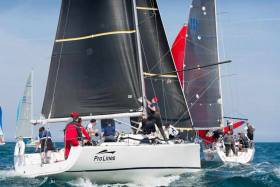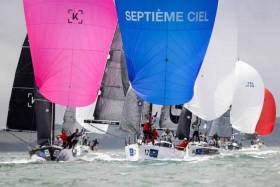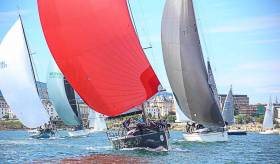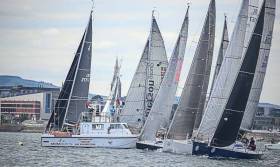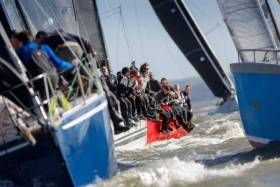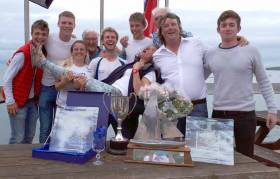Displaying items by tag: IRC
Waterford Harbour's Rob McConnell sailing the Archambault A35 'Fools Gold' has moved up from 18th to 14th from a fleet of 49 after the first four races in Class C of The Hague Offshore Sailing World Championships 2018. The Sovereign's Cup champion has five races left to sail in an extremely competitive inaugural IRC/Offshore championships.
Full results are here.
In contrast to the past few days of light shifty winds, today's superb 12-17 knot southerly breeze made for fast and furious racing on all courses of The Hague Offshore Sailing World Championship 2018. And so even with a later 1300 start today, Principal Race Officer Peter Anink informed everyone two inshore races would be held to take advantage of the favorable conditions.
The southerly breeze combined with a south-flowing flood current to bring even more pressure on the water as well as some big waves, so all teams had to be at their best to avoid being over early at the starts and running into turning marks. With an impressive crowd of 49 boats on the start line of the south course area, Class C was particularly difficult to control, but had only one general recall in the day's second race while the A and B classes in the north course area had no start problems at all.
In the AB course area the High wind Triple Number rating option was selected by race managers for scoring both races with winds over 14 knots, while on the Class C course area the High option was used for the first race, and the Medium option for the second as the tide diminished in strength.
Continuing to perform like a well-honed machine, the Pac 52 Team Beau Geste (HKG) sailed well again today and put two more bullets on the scoreboard. Skipper Gavin Brady had compliments all around about the event, the venue and the racing.
 James Chalmers Bengal Magic, the British J35 that races with Irish sail numbers Photo: Sander Van Der Borch
James Chalmers Bengal Magic, the British J35 that races with Irish sail numbers Photo: Sander Van Der Borch
"In seven years of international campaigning, this has been the most friendly venue for support for our team. And we really enjoyed that long race...12 knots, flat water, clear skies: Karl said it was champagne sailing. If we had more races like this we would have more people in the sport for sure."
On the inshore races today, Brady said the competition with Tilmar Hansen's rival TP 52 Outsider (GER) has been helping to push them. "We were trading leads today, and as they keep getting better and better as they learn their new boat, we have to keep our game high."
Another Class A team that proved a threat to the two 52's was Bas de Voogd's Carkeek 40 Hitchhiker (NED), earning a second in the first inshore race of the day by defeating Outsider by only a few seconds in corrected time. This team has roots in the local Dutch offshore sailing scene having campaigned here for years, but recently with this boat has been active in the UK on the Fast 40+ class circuit.
"This has helped us learn a lot and improve our teamwork," says de Voogd. "But we made some changes to the boat last winter and are still getting used to them." Specifically, the team moved the rig aft 40 cm in the boat and moved the rudder forward 30 cm to improve their speed in class racing. Yet in the breezy conditions of today in high-speed offwind sailing with waves, a condition they haven't seen much in the Solent, they had some control issues in the second race.
"We're having a lot of fun in these waves, we just need to do more work on understanding the controls with the new set-up," he said.
In Class B the winner of the first inshore race was Harold Vermeulen's MAT 11.80 Leeloo (NED), whose wild orange and black graphics make her hard to hide on the race course. This good result temporarily pushed them up into second place in the standings behind class leader Santa, Claus Landmark's Landmark 43 from Norway. But a weak 17th place finish in the second race pushed them back into fifth...down, but certainly not out of contention, and the thrill of racing in fresh breeze and waves kept the team in buoyant spirits.
"For us this wind is so cool, we're a planing boat, so we sail very fast," said Vermeulen. "The first race went great, but we had a bad start in the second race, even though we managed to win something back. But one result doesn't do a lot in this fleet, the racing is so close. For us it's going to be tricky to score well in all the conditions we're up against this week because our boat isn't optimized like many others in our fleet. We're just enjoying a great week of sailing, and for the scoring it's so far, so good."
The team currently lying second in the Class B standings was not happy after yesterday's long race results and felt the event was sliding away from them.
"We were not happy that the long distance race had so much points value and had so much reaching and seemed to favour the boats with asymmetric spinnakers," said members of Martin Estlander X-41 Xini Freedom (FIN) last night. And yet this team has been a proven performer from years of one-design racing in the competitive X-41 class and they have used these skills to do well in many European and World Championships. They showed that today in earning their share of tied 4th and 2nd places respectively, in the first and second inshore races. It's no wonder that two other Baltic-based X-41's are also in the top ten - Tiit Vihul's Olympic (EST) in fourth and Soren Junker's Nexus (DEN) in 9th.
Top-ten excellence in windward/leeward course racing has also helped the team lying now in third place in Class B, Alex Sastre's Farr 40 Mr Brightside (NED), on the strength of two 5th places in the offshore races and scores of 2-9 today.
In Class C yesterday's leader, Patrik Forsgren's modified First 36.7 Pro4U (SWE), did well enough to continue to stay atop the leaderboard, but they said it has not been without effort.
"This is an incredibly tight fleet," said Anders Bjork, spinnaker trimmer on Pro4U. "You make the smallest mistakes and you're going to be out of the top ten easily."
The mistake they made today to push them back into 13th in the first race was once again hitting a mark, this time the leeward gate, and then having to do a penalty turn before continuing on the second upwind leg. But the team is upbeat and confident.
"We are actually happy with the scoring in both IRC and ORC, and find it to be pretty fair. The teams that are sailing well are enjoying close racing, and this is the way it should be at this level."
And based on their strong offshore race scores yesterday and reasonable inshore results today, Heiko Pasler's X-362 Sport Static Electric (GER) has kept their second place position in the Class C standings.
Sometimes this close inshore racing gets too close, and the International Jury chaired by Jan Stage had tonight to sort out five protests, all involving Class B and C competitors. Unfortunately Willem Ellemeet's Dufour 40 Flying Dolphin (NED) was caught in the net and penalized DSQ for a port-starboard incident with Alain Bornet's J/109 Jai Alai (NED) in Race 2, driving them from being 3rd place in the standings to much deeper and allowing Kai Mares's Italia 9.98 Immac Fram (GER) to take their place.
Xini Freedom is also in the protest queue tonight, so the morning may reveal new top three standings in Class B too...or not.
Tomorrow inshore racing continues, with an earlier start time of 11:00, and a wind forecast in the light to moderate 7-11 knot range. The first race tomorrow will be the fifth in the series, and thus the worst scores among all but the long offshore race will be discarded to further shuffle the standings. The remaining five inshore races scheduled will need to be completed by the final day Friday.
McConnell's 'Fools Gold' 18th After Light Air Start To The Hague Offshore Sailing Worlds
Waterford Harbour's Rob McConnell sailing the Archambault A35 'Fools Gold' is lying 18th from a fleet of 49 after the first two offshore races in Class C of The Hague Offshore Sailing World Championships 2018.
Full results are here.
After over 24 hours of sailing in light air off the Dutch North Sea coast, the opening act of The Hague Offshore Sailing World Championship has now concluded and the leaders are now known in each of three classes before the second stage of inshore racing begins tomorrow.
Scoring has been for a long race of 155 miles for Class A with a scoring gate at 70 miles, and a long race of 135 miles for Classes A and B with a scoring gate at 60 miles. Thus each class has two offshore races in their results: a short race worth 1.0 points weighting and a long race worth 2.0 points weighting.
After a start postponed until 12:30, each fleet started off in light 6-9 knot conditions that varied in strength and direction for the rest of the day and evening, reaching a high of about 12 knots at sunset before dropping again into single digits towards morning. With shifting breeze and currents at near springs in strength, it was a challenging night for all.
"It was a good course and a good test," said Eddie Warden-Owen, guest strategist aboard Tilmar Hansen's TP 52 Outsider. "We did not have the sail inventory options that Beau Geste had, and had to make some compromises - like going west of the windfarm on the final long leg to the finish - but it was a good race with lots of elements to make it interesting."
Outsider spent most of their race in lock-step behind Karl Kwok's Pac 52 Beau Geste, who won both races by a comfortable margin, with Outsider second and the Ker 46 Van Uden youth team in third, led by Volvo Ocean Race veteran Gerdjan Poortman and Dutch 470 Olympian Lobke Berkhout as coaches.
The racing in the top of Class B closely resembled that of Class A, with two boats leading the pack and pushing each other throughout their 135-mile track.
Claus Landmark's Landmark 43 Santa took an early lead and was clever to hold on to it throughout the race, due in no small part to the strong navigation skills of another Volvo veteran, Roger Nilsson, who has logged 7 Volvo and Whitbread races around the world.
"It was quite challenging, wind was shifty and we're not very used to the currents you have here, so it's good we had Roger's help," said Landmark "But we kept the boat moving, and since the Worlds in Copenhagen two years ago we have upgraded our rudder with a new design so the boat is going well."
It was another Norwegian Landmark 43, Torkjel Valland's White Shadow, that was never far from Santa and kept the pressure on throughout the race.
"We had some ups and some downs," said Valland. "After the start we got stuck on one of the buoys, and when we got loose, most of the fleet had passed us. But we managed to sail up to the front of the fleet again, until we reached Santa. After that it was back and forward with them. We tried to stick with them, but they continually found a gear and pulled away every time we got to them again. But overall we had a super race, and it gives great promise for the rest of the week. I think the top of this fleet will have some very close racing."
Rounding out the top three in Class B was Michael Berghorn's X-41 Halbtrocken 4.0 from Germany. All top three teams scored 1-2-3 in each of the two races.
Class C was more interesting, with no clear dominance in the results like in the other two classes. Instead there were different leaders in the results of each race, sometime with dramatic differences in scores.
In scoring at the gate for Race 1, a local designed and built 35-footer, Jan Boort's New Frontier, was ahead of the pack on elapsed time by over seven minutes yet corrected to third place, while Gideon Messink's J/112E J Lance 12 corrected to first and Michael Mollman's X 37 Hansen was second. But in the last long leg of the race this was all to change.
Just northwest of the harbor at Ijmuiden in the mid-morning breeze, about 25 miles from the finish, J Lance 12 and Hansen on rhumb line managed to get ahead of New Frontier, who was hedging a little closer to the beach to the east. Like a car wreck on the highway, J Lance stops, followed by Hansen and the pack of 3 other boats around them: the Farr 30 Cheyenne (SWE), the Melges 32 Old Jug (GER) and the Cussutti 36 Katariina II (EST). New Frontier shoots into the lead, but then strays west away from the middle track just west of Ijmuiden and starts to slow too.
Meanwhile, like a passing train, the Waarschip 36 Hubo (NED) came on fast from nowhere to grab the lead and never let it go for the remaining 20 miles to the finish. Others seeing Hubo do this end-around jumped on the train too, leaving those to the west helpless, with only Katariina and Hansen able to get out of the trap.
"We did not do very well in the first part of the race," said skipper Eric van Vuuren, "but we did have a game plan to hit the beach hard on the final leg and pick up the offshore breeze."
"Besides the weather forecast and knowing the tides, we also used the AIS system quite a bit to see what the others were doing," said Hubo navigator John van der Starre.
The results were spectacular, slinging Hubo and others in their wake into the lead to finish well ahead of many other rivals who were ahead of them at the scoring gate. And while Hubo still had to settle for a 4th in corrected time in this race, this was much better than the 34th earned in the first race
So, after all this drama in Class C it should be no surprise that a team who is a consistent performer from years of championship sailing currently has a six-point lead based on their scores of 6-1: Patrik Forsgren's modified First 36.7 Pro4U (SWE). In second is Heiko Pasler's X-362 Sport Static Electric (GER) on scores of 8-3, and currently in third is Alain Bornet's J/109 Jai Alai (NED) on scores of 5-6.
Phase two of the competition at the Offshore Worlds resumes tomorrow with the start of the first of seven planned inshore races. The teams will be given a respite tonight after the long race with a planned start time tomorrow in the afternoon at 1300 local time.
Waterford's 'Fools Gold' To Contest IRC Europeans in Cowes
Sovereign's Cup winner Fools Gold skippered by Rob McConnell from Waterford Harbour Sailing Club will contest the first IRC European Championship ever to be held on the Solent in mid-June. The Irish boat will be hoping for a repeat of the success of Royal Cork's Paul Gibbons, when the Cork Harbour sailor had an IRC Euros class win at the inaugural event, staged as part of Cork Week in 2016.
McConnell launches the race-winning A35 on Monday in Dunmore East after an extensive refit that includes a refaired keel. As Afloat.ie previously reported, Fools Gold, will sail to Howth Yacht Club for June's inaugural Wave Regatta and straight after that the crew head for the Euro contest on the Solent.
But it's only part of an ambitious campaign this season as the Waterford Harbour crew will also contest the first ever IRC/ORC Offshore World Championships in the Hague, a month later.
McConnell's crew, limited to eight, will be similar to the team that won the 2017 Sovereign's Cup and also the IRC Welsh Championships. 2004 Olympian Tom Fitzpatrick is tactician, Roy Darrer is helmsman, Skipper McConnell is mainsail trimmer, Graham Curran is trimmer number one, Dougie Power is trimmer number two, Brian O'Donnell is mastman, Lisa Tait is in the Pit and the bowman is to be announced. Chris Frost will come onboard as a guest navigator for the Solent event.
The Solent represents the spiritual home of IRC, the rating rule which the Royal Ocean Racing Club runs jointly with its French counterpart, the Union Nationale pour la Course au Large. It is also historically significant - Cowes Week was first held here in 1826 and the first America's Cup (as it would become) in 1851. The Round the Island Race, today one of the largest participation events in sailing, starts from here as does the RORC's own Rolex Fastnet Race, first held in 1925, and now the world's largest offshore race. Running over 10-16th June, the IRC Europeans, the most prestigious title to win under the RORC/UNCL's rating rule, will mark a new chapter in Solent yacht racing history.
British and French boats are traditionally strongest competitors under IRC: A British boat has won the RORC Seasons Point Championship for the last two years, but in 2015 France owned the entire podium. French boats have won the last three Rolex Fastnet Races and are the present holders of the Commodores' Cup, which a British team last won in 2012.
There will be no let-up in Anglo-French competition this season with both sides campaigning examples of IRC's hottest new boat: The 1180 comes from JPK Composites, who's 1080 won the 2015 Rolex Fastnet Race, while their 1010 claimed it in 2013 - both campaigned by top French crews. Another Jacques Valer design, the 1180 has more volume forward and a more pronounced chine.
Campaigning JPK 1180 #1 is French legend Géry Trentesaux, the 2015 Fastnet winner who led the French Commodores' Cup team to victory in 2006. His Courrier Recommande finished second to a runaway TP52 in her first outing at Spi Ouest-France over Easter. The IRC Europeans will be one of her first major events: "I like to sail in Cowes and I am a member of the RORC, so it is a good idea to come and race against all my English friends," says Trentesaux.
The IRC Europeans schedule follows the same well-refined format as the Commodores' Cup with eight inshore races (windward-leewards, round the cans, some reaching starts), an Around the Isle of Wight (1.5x coefficient) and a 150 mile/30-36 hour offshore (2x coefficient). "The offshore races are not so big," says Trentesaux. "And Cowes in June is wonderful - I am very happy to come back. But we have a new boat. At present she is okay in strong and light weather, but not in medium downwind - we don't have enough spinnaker area. Otherwise she is very nice."
Also campaigning a JPK 1180 at the IRC Europeans is Britain's Tom Kneen. "It will be a really interesting week between Sunrise and Courier, but they will have some more weeks training than us," he says. Compared to the wily veteran Trentesaux, Kneen is much newer to sailing having only acquired his first boat four years ago. Since then he has been enthusiastically campaigning his boats, which, like Trentesaux, culminated in a JPK 1080.
Kneen acknowledges that winning the IRC Europeans is a big ask. "Four years ago I had no idea that one day winning the IRC Europeans would be an ambition. If we came out on top I would be bouncing off the walls with excitement. If we podium I will be dancing!" Kneen is also gathering a three boat team to compete in the Commodores' Cup, which for the first time is being scored concurrently with the IRC Europeans.
The 2018 IRC Europeans is open to yachts with IRC Endorsed certificates and TCCs of 0.995 up to 1.270. At the grand prix end the line-up includes FAST 40+s like Mike Bartholomew's former GP42 Tokoloshe II and James Neville's HH42 INO XXX and the de Graaf family from the Netherlands on their newly acquired Ker 43 Baraka GP. But the event provides ample opportunity for smaller boats to come out on top - if they are sailed well.
Paul Gibbons' Quarter Tonner Anchor Challenge won in Cork in 2016
In fact the first two IRC Europeans winners were among the shortest: Paul Gibbons' Quarter Tonner Anchor Challenge won in Cork in 2016 while in Marseille last year Guy Claeys' JPK 10.10 Expresso 2 was crowned IRC European Champion, racing in IRC Four.
Among the lowest rated boats competing this year is Mike Bridges' Elan 37 Elaine. Since Bridges acquired her 13 years ago Elaine has been a regular at the IRC Nationals. The IRC Europeans, he says, is just the next step up. "We were looking for something different to do. This came up and we thought we'd give it a crack. We are not doing any other big regattas this year."
Elaine is kept in top condition for racing, she's dry-sailed and with the help of North Sails, Bridges has had her converted to a non-overlapping headsail set-up to lower her IRC rating. These days he admits they don't do much racing offshore, but they have all the experience and it isn't daunting for them. However "if there is some breeze, we'll be alright. If it is light and horrible, we'll be at the back of the fleet," he warns.
The RORC IRC Europeans takes place over 10-16 June 2018 with a race around the Isle of Wight on Monday 11th June and the overnight race over the Wednesday-Thursday, 13-14th June.
Following its debut as part of Cork Week in 2016 and a stand-alone event held in Marseille in 2017, the IRC European Championship this year will take place out of one of its spiritual homes. Coming to Cowes for the third edition and for the first time in the UK, a record-sized fleet will compete in the 2018 IRC European Championship. It will be one of the most prestigious regattas ever run for IRC, the rating rule created and managed jointly by the Royal Ocean Racing Club and the Union Course au Large in France.
The event is open to yachts with IRC TCCs of 0.995-1.270. This equates to Sun Fast 3200, X34s, HOD35 at the smaller end up to FAST 40+s at the top. The fleet will be split into classes, but at the end of the week a single IRC European Champion will be crowned. Last year's winner was the St Tropez-based JPK 10.10 Expresso 2 skippered by Guy Claeys, but perhaps it could be third time lucky for the big boats?
Already FAST40+ yachts including James Neville's Ino XXX and Mike Bartholomew's Tokoloshe have signed up for the event. RORC Admiral Andrew McIrvine and his heavily campaigned First 40, La Réponse will also be on the start line: "The IRC Europeans are completely different to the IRC Nationals because the Nationals have no offshore element, so the Europeans will be a much more intense competition than we normally get. It should make it more attractive to overseas entries especially from France, Belgium, Holland and as far away as the Baltic and will support IRC racing in those areas."
The race format for the IRC Europeans will be a challenging mix of inshores and offshores - similar to that used previously for Commodores' Cups. It will comprise up to 10 inshore races (including windward-leewards, round the cans, some reaching starts, etc), a race around the Isle of Wight (carrying a 1.5x points coefficient) and a 150 nautical mile/30-36 hour offshore race (set in the central Channel to suit the wind direction and strength and coming with a 2x coefficient).
Strong entries are already being fielded by the Netherlands, Denmark and the USA. A strong turn-out is also anticipated from French, given that boats from the south side of the Channel have dominated so many of the RORC's major offshores recently, not only winning the last three Rolex Fastnet Races outright but having the majority of finishers in the top 10 in each too.
Incorporating the Commodores' Cup
France also has a title to defend as the IRC European Championship will this year incorporate the Commodores' Cup, the RORC's biennial event for three boat teams with amateur crews.
To simplify putting teams together, for 2018 the Commodores' Cup has been fully opened up. Boats must comply with the overall IRC TCC limits for the IRC Europeans, but there are no longer any class restrictions for Commodores' Cup boats, nor a requirement for one to be a 'big boat'. Similarly, teams are no longer have to enter the event as nations via their Member National Authority. Instead teams can decide themselves whether they wish to represent a nation or a region or their yacht club or simply three likeminded friends with boats can get together, regardless of their nationalities.
Any boats entering the IRC Europeans can be part of Commodores' Cup teams, however as the Commodores' Cup is a competition for Corinthian crew, boats entering in this will be limited to having one World Sailing categories Group 3 'professional' aboard. The number of pros on board is unrestricted on boats only entering the IRC Europeans.
Andrew McIrvine's La Réponse will be entering the Commodores' Cup once again with a British team: "The Commodores' Cup style of competition has always been very challenging with continuous pressure through the week. To allow a much bigger fleet in the Europeans as well as the team entries in the Commodores' Cup will make the event much more competitive."
Chris Stone, Racing Manager of the RORC added: "With the IRC European Championship coming to Cowes for the first time, we are expecting it to be the most significant events ever held for IRC. That will be very exciting. Plus the format provides a great mix of courses with the inshores in the Solent, the race around the Isle of Wight and the longer offshore. With those mixed courses we will certainly see different boats up front.
RORC Says IRC Certificates Show Positive Start for 2018: Irish Take Up 'Same as Last Year'
The International Rating Certificate (IRC) has made a flying start to 2018 with increased numbers of rating applications in the first month of the year and nearly 1000 certificates issued in January. RORC says 'This is very positive for IRC as certificates are not automatically renewed. Owners must apply for a new certificate through their local IRC Rule Authority and advise any changes to the boat’s configuration before the certificate is issued by the RORC Rating Office or UNCL Centre de Calcul, joint owners and administrators of IRC'.
In Ireland, Irish Sailing says they have have had 50 IRC revalidation applications plus four trial cert applications so far this season. According to Chief Executive Harry Hermon, this is trending 'exactly the same as last year'.
2017 saw total Irish certs of 419 (includes all applications – revalidation, new, trial, amendment etc) so the view is that this will be the same in 2018, with a 'possible small increase'.
March/April/May/June are the peak months for IRC applications in Ireland.
Changes to the IRC rating calculations are implemented every January to cater for technical innovations in yacht design, a practice implemented by the IRC Technical Committee to foster close racing and protect the main fleet while remaining progressive.
Over the last 12 months the Technical Committee has been studying the effects of foils and how they are rated. Boats such as Infiniti 46 Maverick using the Dynamic Stability System will see a change in her rating from which she will benefit for the upcoming RORC Caribbean 600. Other developments for Spinlock IRC 2018 include changes to the calculations affecting: the rating of spinnaker area, sports boats, and boats that set headsails from bowsprits and do not carry spinnakers.
The ‘dayboat’ classification has also been removed from the Rule, leaving assessment of boats’ Offshore Special Regulations compliance to event organisers.
Don't Mention Handicaps as IRC Changes Rules & Deletes Dayboats
The IRC Yearbook arrived in the post as I prepared to write this week’s Podcast. It is sent out together with your notice to renew your Handicap for the season ahead. Only, ‘oops’, the word ‘Handicap’ is no longer acceptable.
Peter Wykeham-Martin, Chairman of the IRC Congress, writes an editorial in the yearbook where he asks all IRC Certificate holders, or as it has been called for many years, a ‘Handicap’ to “please don’t use the word ‘handicap’ when talking about IRC.”
“Handicaps,” he says, “are what you bet on in horse racing and include a jockey’s form.”
“Rating,” Peter declares, “is what we use in IRC to assess a boat’s potential performance – the ability, or lack of ability of the helmsman and crew is not included.”
Is Chairman Wykeham-Martin writing with ‘tongue-in-cheek’ or is he having a ‘dig’ at ECHO ‘handicap’ system – Oops - there’s that word again?
He’ll have a bit of a job to eradicate the description ‘handicap’ from racing, but maybe the desire to do so is part of the changes which are announced in IRC in the very first page of the Yearbook. There are seven Rule Changes listed, plus ‘Definitions’ and other changes.
Amongst them the ‘default’ values for mainsail widths have been deleted, as this was considered inconsistent with the Rule on Headsails.
One of the more fundamental changes in the Rules is the deletion of the ‘Dayboat Definition and Rule 24.’ IRC and its predecessor CHS - remember that ‘handicap system’ –had defined a Dayboat as one which could not comply with Offshore Special Regulations and so Rule 24 stipulated a minimum self-righting angle and items that IRC-rated or ‘handicapped’ depending upon your regard for words and the Chairman’s view, should carry. In quite a few instances ‘Dayboat’ definition seemed to have a relevance to lifelines and, so could refer to boats from 1720s to J Class Yachts.
If you are an IRC holder, look it all up in the yearbook, but don’t mention the word ‘handicap’ if you want to ‘rate’ with the IRC afficionados!
Listen to the Podcast here.
It is now confirmed that the International Paint Poole Regatta 2018 on the English south coast will be hosting a record number of championships. Five UK National Championships and two Southern Area Championships have been confirmed for the regatta so far. As the weeks go by, the 2018 regatta is shaping up to be the biggest and best since its re-launch in 2000 and the regatta committee are still working tirelessly to add exciting new features.
The classes holding their National Championship at Poole are the J24, HP30, MOCRA, VPRS and 2.4mR. The 2.4mR class will also be holding their Tidal Championship at Poole Regatta.
With no IRC National Championship in 2018 and the European Championship being held in Cowes limited to boats rating over 0.995, the IRC Southern Area Championship being run as part of the regatta takes on a far greater significance this year. With at least three IRC classes planned, crews are expected to use the event either as their premier championship in 2018 or as a warm-up for the Europeans taking place in June. The Shrimper class will also be holding their Southern Championship during the weekend.
The regatta committee confirmed to Afloat.ie that they will offer free berthing during the regatta for any entrants travelling from Ireland.
Hopefully that is of interest to your racing community and provides that little extra incentive to head round to the channel and compete. The regatta is just a few days before Poole Boat Show and a couple of weeks before the IRC European Championships, so it could be a good warm up event for anyone participating there.
“With so much silverware available to win, multiple race courses designed to provide dynamic racing for each class and our renowned social events, we really feel that The International Paint Poole Regatta 2018 is going to exceed previous editions in terms of competitive activity on the water and overall event atmosphere. We still have a lot of work to do before May, but can’t wait to host these competitive championships.” Martin Pearson - Regatta Chairman.
To find out more about Poole Regatta click here.
Entry Opens for IRC European Championship & Commodores' Cup + all RORC races on 8th January 2018
At midday on Monday 8th January 2018 entry will open for all Royal Ocean Racing Club (RORC) races, including the Season's Points Championship comprised of 14 races, as well as the highlight of the UK Solent season - the IRC Europeans and Commodores' Cup.
Competitors entering the IRC Europeans (8-16th June) are invited to form a team of three boats with members of their own yacht club or with boats from their region. Alternatively, contact the RORC Race Team who will provide a list of boats entered, but not yet part of a team.
The biggest contest in the 2018 RORC programme is the Sevenstar Round Britain and Ireland Race on Sunday 12th August. At 1,805 nautical miles, it is three times longer than a Fastnet Race and attracts experienced offshore sailors looking for a serious challenge. Starting and finishing in Cowes, it is on a four-year cycle due to the toughness of the race. Circumnavigating all the islands of the UK, including the most northerly point Muckle Flugga, it negotiates headlands with tidal challenges all around the UK and faces the notorious British weather.
The Royal Ocean Racing Club's UK domestic season fires up with the Easter Challenge (30th March to 1st April) and offers crews the chance to work on pre-season training and fine-tuning. With the relaxation of RRS41, the highlight of the event is the availability of a selection of experienced coaches on the water to assist with getting back up to speed.
Lady Mariposa Over the Moon, Boyd's Lisa Wins RORC IRC 2 Race To Cherbourg
Ker 46 Lady Mariposa, skippered by Daniel Hardy, has won the 2017 RORC Cherbourg Race, after holding off a strong challenge from James Neville's HH42 Ino XXX writes Louay Habib. After IRC time correction, 29 seconds was the winning margin, after a high speed blast to Cherbourg across the English Channel. Edward Broadway's Ker 40 Hooligan VII was third, completing the podium for overall honours. The 75 mile race featured a tight reach west out of the Solent, followed by a moon-lit downwind sprint to Cherbourg across the English Channel.
“We were over at the start, as was Ino XXX, so the race didn't start well. We re-started correctly and then went for the island shore, which worked out well for tidal relief. As the last start of the race, we had to work our way through the whole fleet, and after a luffing match with Bob, we were in clear air after the Needles, and put our foot down. The wind speed was up to about 20 knots from the north west, we were surfing towards a rising moon, just classic offshore racing, swapping out grinders and giving it our all. During the night, the wind speed decreased, and with a westerly going tide, we had to be careful not to heat up too much in the quest for speed, and end up too high at the finish. We lost track of Ino XXX but we knew it would be close, so to just get the win, was very satisfying.”
In IRC Zero, Lady Mariposa was the winner, and now leads the class for the season. Ross Hobson's Open 50 Pegasus Of Northumberland, racing Two Handed, was second for the Cherbourg Race, and Stephen Durkin's Farr 52 Bob, sailed by Jonathan Tyrrell, was third. In IRC One, Ino XXX was the winner, and now leads the class for the season. Hooligan VII was second for the Cherbourg Race, and Tor McLaren's MAT 1180 Gallivanter, sailed by Andrew Horrocks, was third.
In IRC Two, the race winner was Nick & Suzi Jones' First 44.7 Lisa, sailed by RORC Commodore Michael Boyd. Lisa was just seven seconds ahead of Gilles Fournier's J/133 Pintia, after IRC time correction. Christopher Daniel's J/122e Juno was third. Suzi Jones has competed in all races on Lisa this season, juggling commitments, including bringing up three young children. “You need a really good babysitter, looking after three young boys is a tough job” commented Suzi. “I miss them dearly but it gives me a bit of a rest. On board Lisa, we have quite a young crew, so I can be mother to them too! Above all I love racing with the RORC because I am ultra competitive, and I love winning.”
In IRC Three, Ed Fishwick's Sun Fast 3600 Redshift Reloaded, racing was the winner by less than a minute after IRC time correction. Delamare & Mordret's JPK 1080, Dream Pearls was second, and Rob Craigie's Sun Fast 3600 Bellino, racing Two Handed, was third. In IRC Two Handed, Redshift Reloaded was the winner, Bellino second, and Ian Hoddle's Sun Fast 3600 Game On was third. Bellino has retained the lead in IRC Two Handed for the RORC Season's Points Championship.
In IRC Four, Jerome Desvaux's Sprint 108 Jurassic - Captain Corsaire, scored a memorable victory over fellow French competitor Noel Racine, racing JPK 10.10 Foggy Dew. Paul Kavanagh's S&S Swan 44 Pomeroy Swan, was third for the race, and moves up to second, behind Foggy Dew, for the RORC Season's Points Championship.
At the Prize Giving held at the Yacht Club de Cherbourg, RORC Commodore, Michael Boyd, spoke on behalf of the competitors, thanking the club for their generous hospitality. The President of the Yacht Club de Cherbourg, Jean Le Carpentier, and RORC Racing Manager, Nick Elliott, officiated at the awards ceremony.
Fools Gold Wins at Abersoch Keelboat Race Week
Waterford Harbour Sailing Club's A35, Fools Gold, skippered by Rob McConnell returned to Wales at the weekend for another regatta campaign. Having won the IRC Welsh Nationals in August in Pwllheli, the Dunmore East boat has gone on to win Abersoch Keelboat Week, IRC division one by half a point.
Fools Gold was up against a range of cruiser–racers in her ten boat fleet including J109s, J97s, Corbys and a Beneteau 234.7. Results are here.
16–year–old helmsman, Dunmore East 420 dinghy champion, Geoff Power got his first taste of cruiser–racing on the tiller of Fools Gold.
A two race retirement after a broken rig, was no barrier for McConnell's crew who, among others, squeezed out ISORA overall leader Mojito for the win.
The Wateford crew also won 'Best Visiting Boat' Trophy at Abersoch. The win completes a successful season for McConnell who also clinched Sovereigns Cup overall honours in July.





























